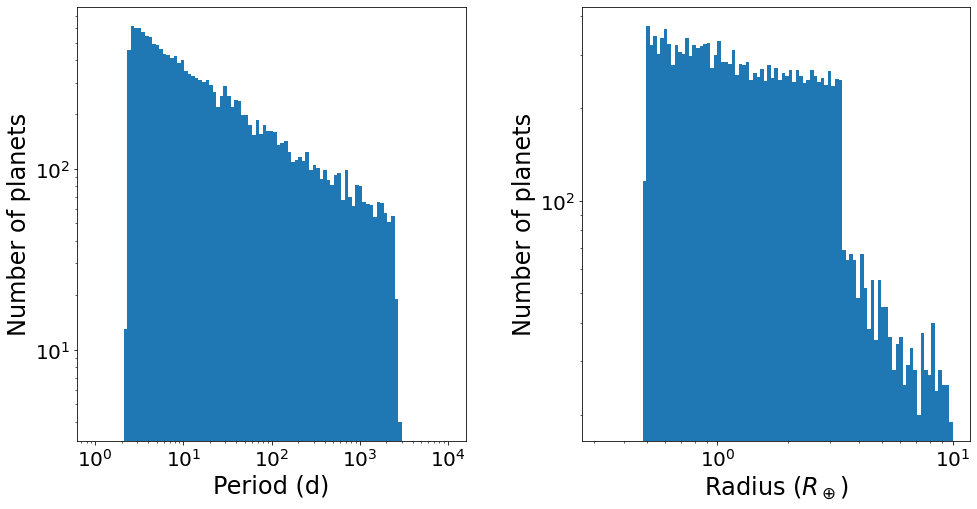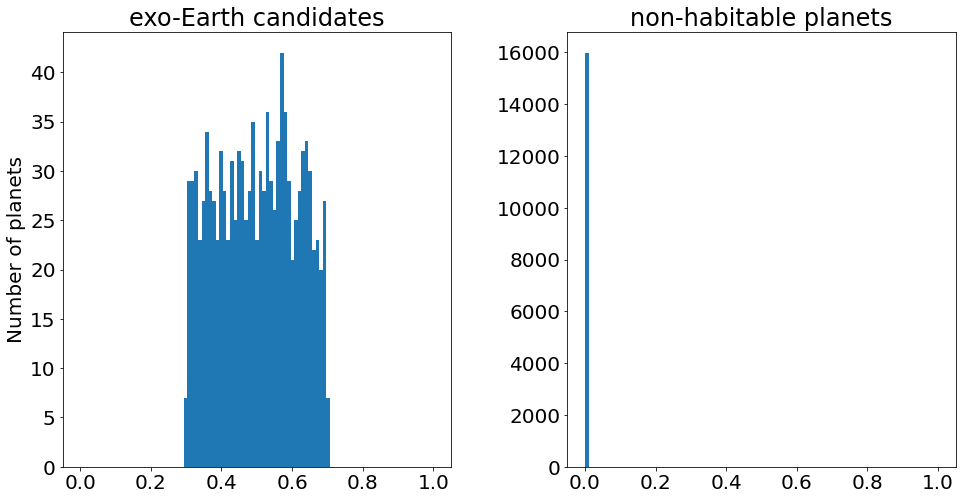Notebooks/Tutorial1.ipynb
Tutorial 1: Generating planetary systems
In this tutorial, we will review how to use the Generator class to generate a sample of planetary systems, including how to add or replace steps in the process.
Setup
Let’s start by importing the necessary module from Bioverse.
[1]:
# Import numpy
import numpy as np
# Import the Generator class
from bioverse.generator import Generator
from bioverse.constants import ROOT_DIR
# Import pyplot (for making plots later) and adjust some of its settings
from matplotlib import pyplot as plt
%matplotlib inline
plt.rcParams['font.size'] = 20.
Loading the Generator
The first step in using Bioverse is to generate a simulated sample of planetary systems. This is accomplished with a Generator object, of which two come pre-installed. Let’s open one of them and examine its contents.
[2]:
# Open the transit mode generator and display its properties
generator = Generator('transit')
generator
[2]:
Generator with 12 steps:
0: Function 'create_stars_Gaia' with 6 keyword arguments.
1: Function 'create_planets_SAG13' with 9 keyword arguments.
2: Function 'assign_orbital_elements' with 1 keyword arguments.
3: Function 'geometric_albedo' with 2 keyword arguments.
4: Function 'impact_parameter' with 1 keyword arguments.
5: Function 'assign_mass' with no keyword arguments.
6: Function 'compute_habitable_zone_boundaries' with no keyword arguments.
7: Function 'compute_transit_params' with no keyword arguments.
8: Function 'classify_planets' with no keyword arguments.
9: Function 'scale_height' with no keyword arguments.
10: Function 'Example1_water' with 3 keyword arguments.
11: Function 'Example2_oxygen' with 2 keyword arguments.
The list above shows each of the steps the Generator runs through in producing the sample of planetary systems. For more information about an individual step, we can display it based on its index:
[3]:
# Show more about the 'create_planets_SAG13' step
generator.steps[1]
[3]:
Function 'create_planets_SAG13' with 9 keyword arguments.
Description:
Generates planets with periods and radii according to SAG13 occurrence rate estimates, but incorporating
the dependence of occurrence rates on spectral type from Mulders+2015.
Parameters
----------
d : Table
Table containing simulated host stars.
eta_Earth : float, optional
The number of Earth-sized planets in the habitable zones of Sun-like stars. All occurrence
rates are uniformly scaled to produce this estimate.
R_min : float, optional
Minimum planet radius, in Earth units.
R_max : float, optional
Maximum planet radius, in Earth units.
P_min : float, optional
Minimum orbital period, in years.
P_max : float, optional
Maximum orbital period, in years.
normalize_SpT : bool, optional
If True, modulate occurrence rates by stellar mass according to Mulders+2015. Otherwise, assume no
dependency on stellar mass.
transit_mode : bool, optional
If True, only transiting planets are simulated. Occurrence rates are modified to reflect the R_*/a transit probability.
optimistic : bool, optional
If True, extrapolate the results of Mulders+2015 by assuming rocky planets are much more common around late-type M dwarfs. If False,
assume that occurrence rates plateau with stellar mass for stars cooler than ~M3.
optimistic_factor : float, optional
If optimistic = True, defines how many times more common rocky planets are around late-type M dwarfs compared to Sun-like stars.
Returns
-------
d : Table
Table containing the sample of simulated planets. Replaces the input Table.
Argument values:
eta_Earth = 0.075
R_min = 0.5
R_max = 14.3
P_min = 0.01
P_max = 10.0
normalize_SpT = True
transit_mode = True
optimistic = False
optimistic_factor = 5
Here we see a short description of the planet generation step as well as its keyword arguments, including eta_Earth. This specifies the average number of Earth-sized planets in the habitable zones of Sun-like stars, and it is currently set to 7.5% (following Pascucci et al. 2020). Let’s change this to a more optimistic value:
[4]:
# Set eta_Earth = 15%
generator.set_arg('eta_Earth', 0.15)
Some arguments are shared by multiple functions - for example, the transit_mode argument tells a couple of functions that only transiting planets are being simulated. By default, it is set to False, but we can change that like so:
[5]:
# Set transit_mode = True for all functions that use it
generator.set_arg('transit_mode', True)
# We can also check on an argument's value as follows:
val = str(generator.get_arg('transit_mode'))
print("\nThe current value of transit_mode is {:s}".format(val))
The current value of transit_mode is True
Running the Generator
Now, let’s use this Generator object to produce an ensemble of transiting planets within 100 parsecs.
[6]:
sample = generator.generate(d_max=100)
print("Generated a sample of {:d} transiting planets including {:d} exo-Earth candidates.".format(len(sample), sample['EEC'].sum()))
Generated a sample of 17081 transiting planets including 1115 exo-Earth candidates.
Let’s plot the period and radius distribution of this planet sample:
[7]:
fig, ax = plt.subplots(ncols=2, figsize=(16,8))
# Period histogram
P = sample['P']
bins = np.logspace(0, 4, 100)
ax[0].hist(P, bins=bins)
ax[0].set_xscale('log')
ax[0].set_yscale('log')
ax[0].set_xlabel('Period (d)', fontsize=24)
ax[0].set_ylabel('Number of planets', fontsize=24)
# Radius histogram
R = sample['R']
bins = np.logspace(-0.5,1,100)
ax[1].hist(R, bins=bins)
ax[1].set_xscale('log')
ax[1].set_yscale('log')
ax[1].set_xlabel('Radius ($R_\oplus$)', fontsize=24)
ax[1].set_ylabel('Number of planets', fontsize=24)
plt.subplots_adjust(wspace=0.3)

Adding new steps
Finally, suppose you want to simulate a new planetary property in Bioverse. For example, suppose you want to assign an ocean covering fraction to each planet (f_ocean_min < f_ocean < f_ocean_max for exo-Earth candidates and f_ocean = 0 for others). We can accomplish this like so:
[8]:
# Define a function that accepts and returns a Table object
def oceans(d, f_ocean_min=0, f_ocean_max=1):
# First, assign zero for all planets
d['f_ocean'] = np.zeros(len(d))
# Next, assign a random non-zero value for exo-Earth candidates
EEC = d['EEC']
d['f_ocean'][EEC] = np.random.uniform(f_ocean_min, f_ocean_max, size=EEC.sum())
# Finally, return the Table with its new column
return d
# Insert this function at the end of the Generator
generator.insert_step(oceans)
# Run the generator with f_ocean_min = 0.3 and f_ocean_max = 0.7
sample = generator.generate(d_max=100, f_ocean_min=0.3, f_ocean_max=0.7)
Now, let’s plot the distribution of ocean covering fractions for EECs and non-EECs:
[9]:
fig, ax = plt.subplots(ncols=2, figsize=(16,8))
f_ocean = sample['f_ocean']
EEC = sample['EEC']
# EECs
bins = np.linspace(0., 1, 100)
ax[0].hist(f_ocean[EEC], bins=bins)
ax[0].set_title('exo-Earth candidates')
ax[0].set_ylabel('Number of planets')
# Non-EECs
ax[1].hist(f_ocean[~EEC], bins=bins)
ax[1].set_title('non-habitable planets')
plt.subplots_adjust(wspace=0.3)

Of course, you may wish to change the oceans function later, and it would be tiring to add it to the Generator again each time. Instead, we can point the Generator to a Python file containing your function, which must be saved under bioverse/functions/.
[10]:
# Reload the generator to erase the previously-added step
generator = Generator('transit')
# Write the function definition as a string
func = """
# Define a function that accepts and returns a Table object
def oceans(d, f_ocean_min=0, f_ocean_max=1):
# First, assign zero for all planets
d['f_ocean'] = np.zeros(len(d))
# Next, assign a random non-zero value for exo-Earth candidates
EEC = d['EEC']
d['f_ocean'][EEC] = np.random.uniform(f_ocean_min, f_ocean_max, size=EEC.sum())
# Finally, return the Table with its new column
return d
"""
# Save the function to a .py file
with open(ROOT_DIR+'/example_oceans.py', 'w') as f:
f.write(func)
# Insert this function into the Generator and specify the filename
generator.insert_step('oceans', filename='example_oceans.py')
# Verify that the new step has been added
generator
[10]:
Generator with 13 steps:
0: Function 'create_stars_Gaia' with 6 keyword arguments.
1: Function 'create_planets_SAG13' with 9 keyword arguments.
2: Function 'assign_orbital_elements' with 1 keyword arguments.
3: Function 'geometric_albedo' with 2 keyword arguments.
4: Function 'impact_parameter' with 1 keyword arguments.
5: Function 'assign_mass' with no keyword arguments.
6: Function 'compute_habitable_zone_boundaries' with no keyword arguments.
7: Function 'compute_transit_params' with no keyword arguments.
8: Function 'classify_planets' with no keyword arguments.
9: Function 'scale_height' with no keyword arguments.
10: Function 'Example1_water' with 3 keyword arguments.
11: Function 'Example2_oxygen' with 2 keyword arguments.
12: Function 'oceans' with 2 keyword arguments.
Now, any changes you make to the oceans function under example_oceans.py will automatically be applied. Finally, you will want to save this Generator under a new name, so that you don’t have to re-add the new step every time you load Bioverse:
[11]:
# Save the new Generator
generator.save('transit_oceans')
# Reload it
generator = Generator('transit_oceans')
The following lines of code will clean up the files created during this exercise:
[12]:
import os
trash = [ROOT_DIR+'/Objects/Generators/transit_oceans.pkl', ROOT_DIR+'/example_oceans.py']
for filename in trash:
if os.path.exists(filename):
os.remove(filename)
The next example will translate this simulated sample of planetary systems into a dataset from a transit spectroscopy survey.